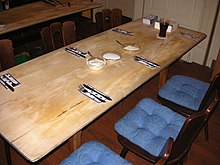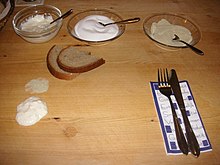Schweinfurt slaughter bowl
The Schweinfurt battle bowl is a traditional custom in Schweinfurt and the surrounding area. There is a particular kind of meat platter (Franconian as Schlachtschüssel called).
procedure
The "Schweinfurter Schlachtschüssel" is not a common slaughter plate, but rather a celebration in a large, sociable round table. The Schweinfurt butcher bowl can not be found on any menu. A minimum number of eaters is required and the process is carried out according to traditional rituals.
The most important feature of a Schweinfurt slaughter bowl is that it is eaten directly on the table , not from plates , but from long wooden boards.
It is a very hearty dish in which different parts of the pork - divided into seven "courses" - are eaten. The meat is previously cooked as kettle meat and served in the following order:
Belly meat - stabbing meat - bow - comb - head meat with tongue , ear and trunk - heart and other offal - kidneys .
The pig parts are placed directly in the middle of the table so that everyone can help themselves at the table. Leftovers that have become cold or can no longer be eaten for other reasons are simply left in the middle of the table or put back there. These leftovers are usually removed from the table after each course. In the past, they were then processed into blood or liver sausage and given to the guests after the meal or the next day. For reasons of hygiene, this is usually no longer practiced today.
Traditionally, only sauerkraut , salt and pepper , horseradish and farmhouse bread are eaten with meat . Horseradish is doing fränkisch as horseradish referred. Franconian wine is usually drunk with a Schweinfurt butcher's bowl.
history
The Schweinfurt butcher's bowl is a meal that the Schweinfurt butcher host Georg Josua Schwanhäusser (1796–1876) first served in 1856 in the Goldener Stern inn at 36 Oberen Gasse. Later other innkeepers from Schweinfurt and the surrounding area took up this idea and so it became a custom.
Due to the EU hygiene regulation, which comes into force on January 1, 2006, a slaughtering bowl in which the meat is eaten directly from the board may no longer be offered for reasons of hygiene. Since the Schweinfurt butcher's bowl has been held in this form for over 150 years, it claims customary law and can continue to be carried out in Schweinfurt as a form of tradition . Because of this traditional character, a battle bowl song is usually sung before the meal begins.
The largest slaughter bowl so far was carried out in 1991 on the occasion of the 1200th anniversary of the city of Schweinfurt with more than 1200 participants.
literature
- Karl H. Hennig: Like to eat: The Schweinfurt battle bowl - history and stories . Reimund Maier, Schweinfurt 2005, ISBN 978-3926300546
Web links
- Internet presence of the city of Schweinfurt: Schweinfurt meat bowl
- Information brochure with a poem about the slaughter bowl ( Memento from January 5, 2009 in the Internet Archive ) (PDF file; 3.27 MB)
- Description of a Schweinfurt slaughter bowl
- Description of the Schweinfurter Schlachtschüssel ( memento from February 1, 2010 in the Internet Archive ) at the BayStMLF

